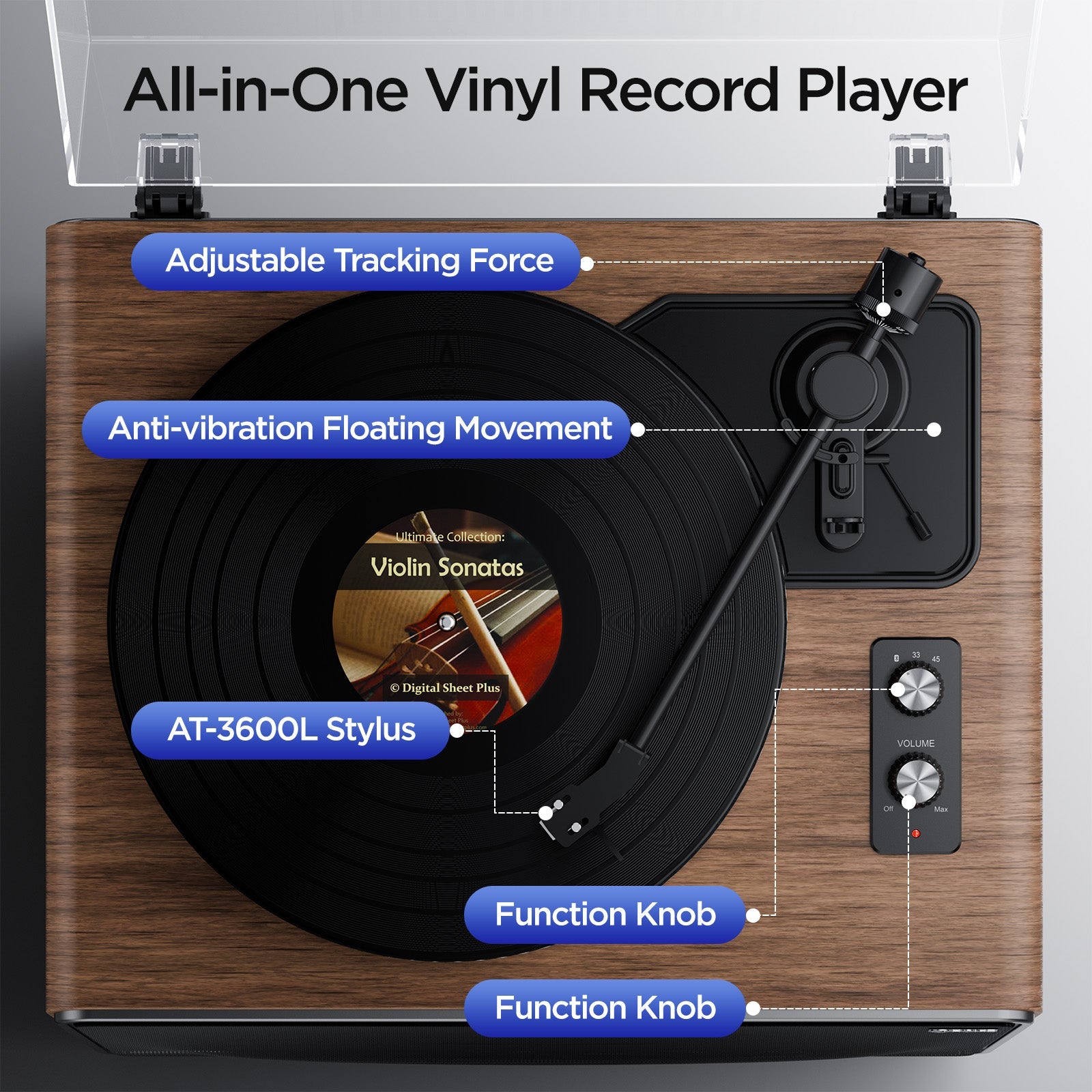There's an undeniable magic to vintage turntables. They hail from an era when hi-fi equipment was often built with a reassuring solidity, an heirloom quality intended to last. The warm, often characterful sound, the tactile experience, the sheer history embedded in their wood and metal – it's an allure that captivates many a vinyl enthusiast. But acquiring a slumbering giant from a bygone decade is just the first step. The real journey, and often the deepest satisfaction, lies in its restoration.
Bringing a vintage record player back to its former glory is more than just a technical exercise; it's an act of audio archaeology, a patient dialogue with a piece of engineering history. It demands respect, research, and a willingness to get your hands dirty. But be warned: it's not always a straightforward path. Time takes its toll, components age, and what seems like a simple fix can sometimes unfurl into a more complex challenge. This guide is for the intrepid audiophile ready to embark on this rewarding quest.
Before You Begin: The Crucial Triage Phase
Resist the urge to immediately plug it in and hope for the best – that can sometimes do more harm than good, especially with electronics that have been dormant for years. Patience and planning are your allies.
-
Identify Your Patient: What exactly have you got? Make, model, and approximate year of manufacture are crucial starting points. The internet is your friend here. Websites like Vinyl Engine (https://www.vinylengine.com/library.shtml) are invaluable archives for service manuals, user guides, and specifications. Knowing what you're dealing with will inform your entire approach, from sourcing parts to understanding its common quirks.
-
Honest Skill Assessment: This is no time for ego. Be brutally honest about your technical abilities. Are you comfortable with a multimeter? Can you wield a soldering iron with precision? Do you understand the basics of mechanical systems and electronics? If not, that's okay! But it means you'll need to factor in the cost of professional help for certain tasks. Overreaching can turn a restorable gem into a parts unit.
-
Define "Restored": What's your end goal?
-
Museum Quality: A faithful restoration using only original or period-correct parts, preserving its exact historical character. This is often the most challenging and expensive route.
-
Reliable Daily Driver: Functional, safe, and sounding great, perhaps with some discreet modern component upgrades (like new capacitors or a modern cartridge) for improved performance and longevity. This is a common and practical goal.
-
"Restomod": A more significant overhaul, potentially incorporating modern conveniences or performance enhancements that deviate from the original design but improve usability or sound for your specific needs.
-
-
Budget Accordingly: Vintage restoration can be a slippery slope financially. Parts, especially rare ones, can be costly. Specialized tools might be needed. And if you enlist a technician, their expertise comes at a price. Set a realistic budget from the outset.
Your Restoration Toolkit: Arming Yourself for the Task
Beyond your standard screwdrivers and pliers, a few specialized tools will make your life significantly easier and your work more professional:
-
Multimeter: Absolutely essential for diagnosing electrical issues, checking continuity, voltages, and resistor values.
-
Soldering Iron & Solder: If you plan on replacing components or repairing wiring, a decent temperature-controlled soldering iron, quality solder, and a desoldering tool (braid or pump) are must-haves.
-
Contact Cleaner: A can of DeoxIT D5 (for general cleaning) and F5 (for fader/potentiometer lubrication) can work wonders on scratchy pots, intermittent switches, and dirty connectors.
-
Good Lighting & Magnification: You'll be dealing with small parts and potentially faded markings. A bright work light and a magnifying glass or visor are indispensable.
-
Service Manual: If you can find one for your specific model (again, Vinyl Engine is your first stop), it's worth its weight in gold. It will contain schematics, parts lists, and disassembly/reassembly instructions.
-
Assorted Small Brushes, Cotton Swabs, Isopropyl Alcohol (90%+): For general cleaning.
-
Digital Camera/Smartphone: Take copious photos before you disassemble anything and at every stage. These will be your lifeline when it's time to put it all back together.
Phase 1: The Archaeological Dig – Deep Clean & Visual Inspection
With the unit unplugged and on a well-lit workbench, the exploration begins.
-
Exterior: Start by thoroughly cleaning the plinth (wood polish for wood, appropriate cleaners for metal or plastic), dust cover (specialized plastic polishes like Novus can work wonders on scratches), knobs, and switches.
-
Interior (Power OFF & Unplugged!): Carefully remove the bottom panel (and sometimes the platter) to access the innards.
-
Dust Bunnies & Grime: Decades of accumulated dust are common. Use a soft brush and a low-power vacuum (carefully!) to remove loose debris. Avoid blasting compressed air indiscriminately, as it can drive dirt into sensitive areas like bearings.
-
Visual Scan: Look for obvious signs of trouble:
-
Leaking or bulging capacitors: These are prime candidates for replacement.
-
Burnt resistors or other scorched components.
-
Frayed or cracked wiring, corroded connectors.
-
Old, hardened grease or oil on mechanical parts.
-
Worn or perished rubber (idler wheels, belts, motor mounts).
-
-
Remember to take photos!
-
Phase 2: Mechanical Rejuvenation – The Tune-Up
Many vintage turntable issues are mechanical.
-
Platter Bearing: This is the heart of the turntable's smooth rotation. It will likely need cleaning of old, gummy lubricant and re-lubrication with fresh, high-quality oil or grease specified for turntable bearings (the service manual is key here, or consult specialist forums).
-
Motor:
-
Cleaning & Lubrication: Some motors have oiling points. Clean any accessible parts.
-
Motor Mounts: Rubber motor mounts can perish, leading to increased vibration and noise. Check and replace if necessary.
-
Brushes/Capacitors: Some AC motors use run capacitors that can drift out of spec or fail, affecting speed. DC motors may have brushes that wear.
-
-
Drive System:
-
Belt-Drive: The belt is almost certainly stretched, dried out, or turned to goo. Replace it with a new one of correct size and profile. Clean the motor pulley and platter sub-rim where the belt rides.
-
Idler-Drive: The rubber idler wheel, which transfers rotation from motor to platter, can become hardened, glazed, or develop flat spots. This causes rumble and speed instability ("wow"). Sometimes, careful cleaning and resurfacing (e.g., lightly sanding the edge) can revive it. Often, replacement is the best option if available. Ensure the idler mechanism engages smoothly.
-
-
Tonearm:
-
Bearings: Gently check for play. The arm should move freely horizontally and vertically with minimal friction and no notchiness or binding. Tonearm bearing issues are often best left to professionals.
-
Cueing Mechanism: If it drops the needle too fast or not at all, the silicone damping fluid in the cueing piston has likely dried up or leaked. This can often be re-filled.
-
Headshell Contacts & Internal Wiring: Clean the contacts where the headshell connects. Inspect the delicate tonearm wires for breaks.
-
Phase 3: Electrical First Aid – The Resuscitation
Safety First! If you are not comfortable or knowledgeable about working with mains voltage or electronics, STOP and consult a qualified technician.
-
Contact Cleaning: This is often a "miracle cure." Use DeoxIT D5 on all switches (power, speed selector), potentiometers (if it's an integrated unit with volume/tone controls), and RCA output jacks. Work the switch or pot back and forth several times after spraying. Follow with DeoxIT F5 (FaderLube) for potentiometers if needed.
-
Capacitor Replacement ("Recapping"): Electrolytic capacitors have a finite lifespan (20-30 years is typical). Old ones can leak, bulge, dry out, or drift in value, leading to hum, poor sound quality, or even component failure. Replacing them, especially in the power supply section, is a common and highly recommended preventative maintenance step in vintage audio.
-
Critical Note: Pay exact attention to polarity, voltage rating, and capacitance value. Use quality replacements from reputable suppliers like Mouser (https.mouser.com) or Digi-Key. This is a task that requires soldering skills and a good understanding of what you're doing.
-
-
Wiring & Solder Joints: Inspect all wiring for breaks, nicks, or insulation damage. Look for "cold" or cracked solder joints, especially on connectors and components that experience physical stress or heat. Reflow suspicious joints.
-
Grounding: Ensure the main chassis ground and tonearm ground connections are clean and secure. Poor grounding is a primary cause of hum.
Phase 4: The Voice Transplant & Fine-Tuning – Cartridge, Stylus, and Setup
This is where the rubber (or rather, diamond) meets the road.
-
Stylus: Unless you have irrefutable proof of its age and low hours, assume the stylus is worn and needs replacement. A worn stylus will sound poor and, more importantly, will permanently damage your records.
-
Cartridge:
-
Originality vs. Performance: Is the original cartridge still good? Are replacement styli readily available and of good quality? Sometimes, upgrading to a modern cartridge that is a good compliance match for the tonearm can yield significant sonic benefits.
-
Headshell Wires: These tiny wires are often fragile and corroded. Replacing them with a new set is inexpensive and can improve signal integrity.
-
-
The Full Monty Setup: Once you have a known-good cartridge and stylus installed:
-
Tracking Force: Use a digital stylus force gauge to set the tracking force according to the cartridge manufacturer's recommendation.
-
Alignment: Use a cartridge alignment protractor (Baerwald, Lofgren, Stevenson are common geometries) to align the cartridge in the headshell. This minimizes tracking error distortion across the record.
-
Azimuth: Ensure the stylus is perpendicular to the record surface when viewed from the front.
-
Anti-Skate: Set the anti-skate (bias compensation) to counteract the natural inward pull on the tonearm.
-
Phase 5: The Shakedown Cruise – Testing and Troubleshooting
Connect the turntable to an amplifier and speakers (initially, use a record you don't mind sacrificing, just in case something is drastically wrong).
-
Speed Check: Does it run at the correct speed? Use a strobe disc (printable online) and a suitable light source, or a dedicated RPM app on your phone. Adjust speed controls if available and necessary. Listen for wow (slow speed variations) and flutter (fast variations).
-
Listen Critically:
-
Hum or Buzz: Often grounding issues, or problems in the phono preamp stage.
-
Static or Crackle (not from the record itself): Could be dirty contacts, failing components.
-
Channel Imbalance or Dropout: Check all connections, from headshell wires to RCA cables. Could also be internal wiring or component issues.
-
Distortion: Could be misalignment, incorrect tracking force, worn stylus, or electronic issues.
-
-
Troubleshoot Methodically: If problems arise, don't change multiple things at once. Make one adjustment or check one connection at a time. Refer to your service manual and online forums – chances are someone has encountered your specific issue before.
Knowing Your Limits: When to Call a Professional
There's no shame in admitting a task is beyond your current skill set or tooling. A good audio technician can be a lifesaver. Consider professional help for:
-
Complex electronic faults that defy your diagnostic abilities.
-
Tonearm bearing damage or intricate tonearm rewiring.
-
Motor issues requiring specialized tools or knowledge (e.g., rebuilding certain types of motors).
-
If you simply lack the time or patience and want the job done right.
The XJ-HOME Perspective: A Legacy of Sound, Preserved with Passion
At XJ-HOME, we are deeply passionate about the enduring magic of analog sound and the craftsmanship that goes into creating exceptional audio experiences. While our focus at https://xenonjade.com is on providing enthusiasts with new, meticulously engineered components and accessories that embody the pinnacle of modern audio performance and design, we hold immense respect for the legacy of vintage hi-fi.
The act of restoring a vintage turntable is a profound expression of this passion. It's about honoring the ingenuity of past designers, preserving a tangible piece of audio history, and reconnecting with music through an instrument that has its own unique story to tell. This dedication to quality, longevity, and the authentic reproduction of sound is a spirit we strive to embody in everything we do.
Conclusion: The Sweet Sound of Revival
Restoring a vintage record player is a journey that can be immensely satisfying. The moment you hear clear, beautiful music emanating from a machine you've painstakingly brought back from the brink is a special kind of triumph. It connects you not only to your music collection but also to a rich history of audio engineering.
It requires patience, diligence, and a willingness to learn. But the rewards – a unique, characterful sound, the pride of accomplishment, and a truly distinctive centerpiece for your audio system – are well worth the effort. So, roll up your sleeves, respect the craft, and get ready to bring that groove back to life. Happy restoring!





Leave a comment
All comments are moderated before being published.
This site is protected by hCaptcha and the hCaptcha Privacy Policy and Terms of Service apply.